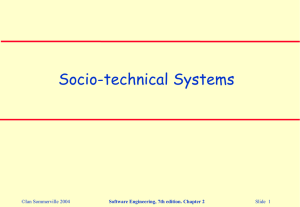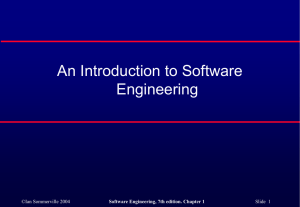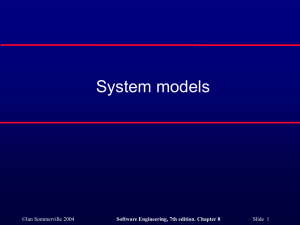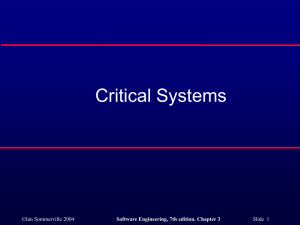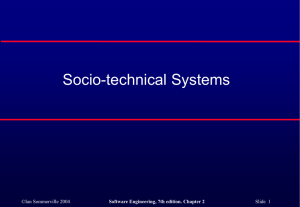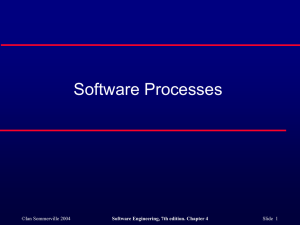Software cost estimation(power point)
advertisement
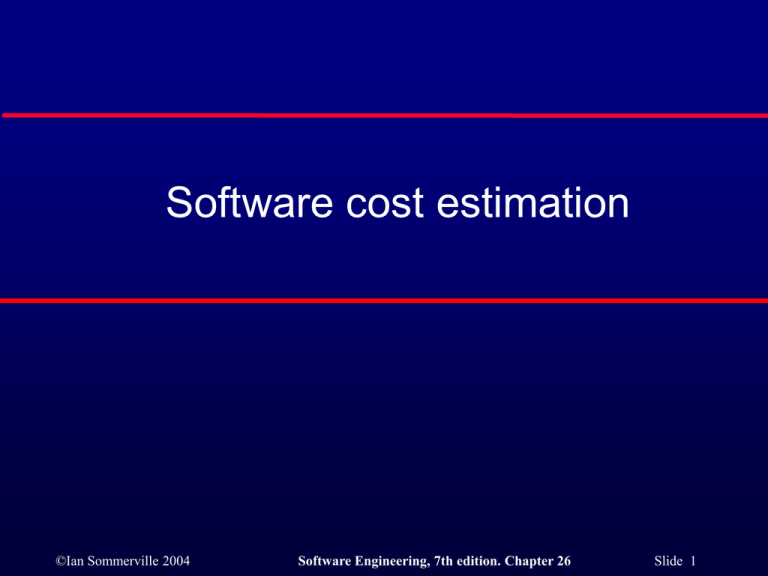
Software cost estimation ©Ian Sommerville 2004 Software Engineering, 7th edition. Chapter 26 Slide 1 Objectives To introduce the fundamentals of software costing and pricing To describe three metrics for software productivity assessment To explain why different techniques should be used for software estimation To describe the principles of the COCOMO 2 algorithmic cost estimation model ©Ian Sommerville 2004 Software Engineering, 7th edition. Chapter 26 Slide 2 Topics covered Software productivity Estimation techniques Algorithmic cost modelling Project duration and staffing ©Ian Sommerville 2004 Software Engineering, 7th edition. Chapter 26 Slide 3 Fundamental estimation questions How much effort is required to complete an activity? How much calendar time is needed to complete an activity? What is the total cost of an activity? Project estimation and scheduling are interleaved management activities. ©Ian Sommerville 2004 Software Engineering, 7th edition. Chapter 26 Slide 4 Software cost components Hardware and software costs. Travel and training costs. Effort costs (the dominant factor in most projects) • • The salaries of engineers involved in the project; Social and insurance costs. Effort costs must take overheads into account • • • Costs of building, heating, lighting. Costs of networking and communications. Costs of shared facilities (e.g library, staff restaurant, etc.). ©Ian Sommerville 2004 Software Engineering, 7th edition. Chapter 26 Slide 5 Costing and pricing Estimates are made to discover the cost, to the developer, of producing a software system. There is not a simple relationship between the development cost and the price charged to the customer. Broader organisational, economic, political and business considerations influence the price charged. ©Ian Sommerville 2004 Software Engineering, 7th edition. Chapter 26 Slide 6 Software pricing factors M a rk et o pp ortu ni ty A d e ve lopm en t org an is at ion m ay qu ote a low p rice b eca us e it w ishes to m ov e into a ne w se gm en t o f th e soft wa re m ark et. A cce p tin g a low pro fit o n on e pro jec t m ay give th e o pp ortu nity o f mo re pro fit late r. The ex p erie n ce g ai n ed m ay al low n ew p ro du ct s t o be de v el o pe d. C os t es tim ate u nce rta in ty If an o rga n isatio n is u nsure of its cos t estim ate, it ma y inc rea se its pri ce b y som e c o ntin ge n cy o v er a n d a bo ve it s no rm al p ro fit. C o ntra ct u al te rms A c us to m er m ay b e w illi n g to al low th e d ev el o pe r to retai n o w n er sh ip o f the sou rc e co de an d reu se it in o th e r project s. Th e p rice ch arge d m ay th en be le ss th a n if th e soft wa re so urce co d e is ha n de d o ve r t o the cu stom er. R e qu irem en ts v ol a tility If th e req u irem en ts are lik el y to ch an ge , an orga nisa tio n m ay low er it s pric e to w in a c o ntra ct. A fte r the co n trac t is aw a rd ed , h ig h p rice s c a n b e c ha rge d fo r c ha n ge s t o th e req uirem en ts. F in an c ia l he alt h D ev e lo p ers in fin an c ia l diffic ul ty m a y low er th eir pr ice to ga in a c on tract . It is be tte r to m a ke a sm alle r th an no rma l p rof it or b re a k ev en t h an t o g o o ut of b usine ss. ©Ian Sommerville 2004 Software Engineering, 7th edition. Chapter 26 Slide 7 Software productivity A measure of the rate at which individual engineers involved in software development produce software and associated documentation. Not quality-oriented although quality assurance is a factor in productivity assessment. Essentially, we want to measure useful functionality produced per time unit. ©Ian Sommerville 2004 Software Engineering, 7th edition. Chapter 26 Slide 8 Productivity measures Size related measures based on some output from the software process. This may be lines of delivered source code, object code instructions, etc. Function-related measures based on an estimate of the functionality of the delivered software. Function-points are the best known of this type of measure. ©Ian Sommerville 2004 Software Engineering, 7th edition. Chapter 26 Slide 9 Measurement problems Estimating the size of the measure (e.g. how many function points). Estimating the total number of programmer months that have elapsed. Estimating contractor productivity (e.g. documentation team) and incorporating this estimate in overall estimate. ©Ian Sommerville 2004 Software Engineering, 7th edition. Chapter 26 Slide 10 Lines of code What's a line of code? • • The measure was first proposed when programs were typed on cards with one line per card; How does this correspond to statements as in Java which can span several lines or where there can be several statements on one line. What programs should be counted as part of the system? This model assumes that there is a linear relationship between system size and volume of documentation. ©Ian Sommerville 2004 Software Engineering, 7th edition. Chapter 26 Slide 11 Productivity comparisons The lower level the language, the more productive the programmer • The same functionality takes more code to implement in a lower-level language than in a high-level language. The more verbose the programmer, the higher the productivity • Measures of productivity based on lines of code suggest that programmers who write verbose code are more productive than programmers who write compact code. ©Ian Sommerville 2004 Software Engineering, 7th edition. Chapter 26 Slide 12 System development times A na lys is Ass em bly c o de H ig h-le v el la n gu ag e Ass em bly c o de H ig h-le v el la n gu ag e ©Ian Sommerville 2004 3 w e ek s 3 w e ek s D esig n C od ing T es ting 5 w e ek s 5 w e ek s 8 w e ek s 4 w e ek s 10 w ee k s 6 w e ek s D oc u me nt ation S iz e E ff or t Pr od uc tivi ty 5 00 0 lin es 1 50 0 lin es 2 8 w ee ks 2 0 w ee ks 7 14 line s/m o nth 3 00 line s/m o nth Software Engineering, 7th edition. Chapter 26 2 w e ek s 2 w e ek s Slide 13 Function points Based on a combination of program characteristics • • • • external inputs and outputs; user interactions; external interfaces; files used by the system. A weight is associated with each of these and the function point count is computed by multiplying each raw count by the weight and summing all values. UFC = (numb er o f elemen ts of given type) (we ight) ©Ian Sommerville 2004 Software Engineering, 7th edition. Chapter 26 Slide 14 Function points The function point count is modified by complexity of the project FPs can be used to estimate LOC depending on the average number of LOC per FP for a given language • • LOC = AVC * number of function points; AVC is a language-dependent factor varying from 200300 for assemble language to 2-40 for a 4GL; FPs are very subjective. They depend on the estimator • Automatic function-point counting is impossible. ©Ian Sommerville 2004 Software Engineering, 7th edition. Chapter 26 Slide 15 Object points Object points (alternatively named application points) are an alternative function-related measure to function points when 4Gls or similar languages are used for development. Object points are NOT the same as object classes. The number of object points in a program is a weighted estimate of • • • The number of separate screens that are displayed; The number of reports that are produced by the system; The number of program modules that must be developed to supplement the database code; ©Ian Sommerville 2004 Software Engineering, 7th edition. Chapter 26 Slide 16 Object point estimation Object points are easier to estimate from a specification than function points as they are simply concerned with screens, reports and programming language modules. They can therefore be estimated at a fairly early point in the development process. At this stage, it is very difficult to estimate the number of lines of code in a system. ©Ian Sommerville 2004 Software Engineering, 7th edition. Chapter 26 Slide 17 Productivity estimates Real-time embedded systems, 40-160 LOC/P-month. Systems programs , 150-400 LOC/P-month. Commercial applications, 200-900 LOC/P-month. In object points, productivity has been measured between 4 and 50 object points/month depending on tool support and developer capability. ©Ian Sommerville 2004 Software Engineering, 7th edition. Chapter 26 Slide 18 Factors affecting productivity A pp li c at ion d om ai n ex pe rie nc e K no w led g e o f th e ap plica tio n d om ain is esse nt ial fo r effe c tiv e soft wa re d ev el o pm en t. En g in ee rs w h o al rea d y un de rs ta nd a d om ai n are li k el y t o b e the m os t prod uc tiv e. P ro ce ss qu ali ty T h e de ve lopm en t p ro ce ss us ed ca n ha v e a s ig nifica n t eff ect on p ro du ct ivity . Th is is co v ered in C h ap ter 2 8 . P ro je ct size T h e la rg er a p ro je ct, th e m ore tim e re q uire d fo r tea m com m u nica tio ns. Le ss tim e is av a il a bl e for de ve lopm en t so in dividu al prod uc tiv it y is re du ce d . Tec h no lo gy sup por t G oo d su pp ort tec h no lo gy suc h as C AS E to ols , co nfig uratio n m an age me nt s ystems , e tc. c an im prov e pr od uc tiv it y . W orking en viro nm en t As I dis cu ssed in C ha p te r 2 5, a q uiet wo rk in g e nv ironm en t w ith p riva te w ork ar e as c o ntribu te s t o im pro ve d pro du ct ivity . ©Ian Sommerville 2004 Software Engineering, 7th edition. Chapter 26 Slide 19 Quality and productivity All metrics based on volume/unit time are flawed because they do not take quality into account. Productivity may generally be increased at the cost of quality. It is not clear how productivity/quality metrics are related. If requirements are constantly changing then an approach based on counting lines of code is not meaningful as the program itself is not static; ©Ian Sommerville 2004 Software Engineering, 7th edition. Chapter 26 Slide 20 Estimation techniques There is no simple way to make an accurate estimate of the effort required to develop a software system • • • Initial estimates are based on inadequate information in a user requirements definition; The software may run on unfamiliar computers or use new technology; The people in the project may be unknown. Project cost estimates may be self-fulfilling • The estimate defines the budget and the product is adjusted to meet the budget. ©Ian Sommerville 2004 Software Engineering, 7th edition. Chapter 26 Slide 21 Changing technologies Changing technologies may mean that previous estimating experience does not carry over to new systems • • • • • • • Distributed object systems rather than mainframe systems; Use of web services; Use of ERP or database-centred systems; Use of off-the-shelf software; Development for and with reuse; Development using scripting languages; The use of CASE tools and program generators. ©Ian Sommerville 2004 Software Engineering, 7th edition. Chapter 26 Slide 22 Estimation techniques Algorithmic cost modelling. Expert judgement. Estimation by analogy. Parkinson's Law. Pricing to win. ©Ian Sommerville 2004 Software Engineering, 7th edition. Chapter 26 Slide 23 Estimation techniques A lg orit hm ic cos t mo de lling A m od el ba sed o n h istoric a l cos t in fo rm atio n tha t rel a te s som e so ftwa re m et ri c (usu al ly its size ) to th e pr oj e ct co st is us ed . A n es tim ate is m ad e o f tha t m etric a n d th e m od el pred ict s th e e ff ort req uire d . E x pe rt ju dg em en t S ev er a l ex pe rts on th e pr op osed softw are d ev el o pm en t tec h niqu es an d th e a pp li c ati o n dom ai n are co nsu lted . Th e y e ach estim ate th e pro jec t cos t. The se estim ate s ar e co m p ared an d d iscuss ed . Th e estim at ion p ro ce ss ite rat es un til a n agr eed estim ate is r eac h ed . E stim at ion by an al o gy T h is tech n iq ue is a pp li c ab le w he n o th er project s in th e sam e ap p licat ion d om ai n h av e be en co mp le ted . Th e co st o f a ne w pr oject is estim ated by an al o gy w it h the se co mp le ted projec ts. M y ers (M y er s 19 89 ) gi v es a v er y clea r d es cr iptio n of th is a pp ro ac h . P arkinso nÕs La w P arkinso nÕs La w sta te s tha t w ork ex p an ds to fill the time av ail a ble. T h e cos t is de te rm in ed by av ail a ble resou rc es rat h er th an by o bj e ct ive assessm en t. If the softw are h as to b e de li v ered in 12 mo nt hs an d 5 p eo p le ar e av ai lab le, the ef fo rt req u ired is es tim ated to be 60 p er so nm on ths . P rici n g to w in T h e softw are c ost is estim ated to be w h at e ve r the cu stom er h as av ai lab le to sp en d o n th e pro jec t. T h e estim ated ef fo rt de pe n ds o n th e cus to m e rÕs bud ge t an d n ot o n the s oftw are fun ct ion al ity . ©Ian Sommerville 2004 Software Engineering, 7th edition. Chapter 26 Slide 24 Pricing to win The project costs whatever the customer has to spend on it. Advantages: • You get the contract. Disadvantages: • The probability that the customer gets the system he or she wants is small. Costs do not accurately reflect the work required. ©Ian Sommerville 2004 Software Engineering, 7th edition. Chapter 26 Slide 25 Top-down and bottom-up estimation Any of these approaches may be used topdown or bottom-up. Top-down • Start at the system level and assess the overall system functionality and how this is delivered through sub-systems. Bottom-up • Start at the component level and estimate the effort required for each component. Add these efforts to reach a final estimate. ©Ian Sommerville 2004 Software Engineering, 7th edition. Chapter 26 Slide 26 Top-down estimation Usable without knowledge of the system architecture and the components that might be part of the system. Takes into account costs such as integration, configuration management and documentation. Can underestimate the cost of solving difficult low-level technical problems. ©Ian Sommerville 2004 Software Engineering, 7th edition. Chapter 26 Slide 27 Bottom-up estimation Usable when the architecture of the system is known and components identified. This can be an accurate method if the system has been designed in detail. It may underestimate the costs of system level activities such as integration and documentation. ©Ian Sommerville 2004 Software Engineering, 7th edition. Chapter 26 Slide 28 Estimation methods Each method has strengths and weaknesses. Estimation should be based on several methods. If these do not return approximately the same result, then you have insufficient information available to make an estimate. Some action should be taken to find out more in order to make more accurate estimates. Pricing to win is sometimes the only applicable method. ©Ian Sommerville 2004 Software Engineering, 7th edition. Chapter 26 Slide 29 Pricing to win This approach may seem unethical and unbusinesslike. However, when detailed information is lacking it may be the only appropriate strategy. The project cost is agreed on the basis of an outline proposal and the development is constrained by that cost. A detailed specification may be negotiated or an evolutionary approach used for system development. ©Ian Sommerville 2004 Software Engineering, 7th edition. Chapter 26 Slide 30 Algorithmic cost modelling Cost is estimated as a mathematical function of product, project and process attributes whose values are estimated by project managers: • Effort = A SizeB M • A is an organisation-dependent constant, B reflects the disproportionate effort for large projects and M is a multiplier reflecting product, process and people attributes. The most commonly used product attribute for cost estimation is code size. Most models are similar but they use different values for A, B and M. ©Ian Sommerville 2004 Software Engineering, 7th edition. Chapter 26 Slide 31 Estimation accuracy The size of a software system can only be known accurately when it is finished. Several factors influence the final size • • • Use of COTS and components; Programming language; Distribution of system. As the development process progresses then the size estimate becomes more accurate. ©Ian Sommerville 2004 Software Engineering, 7th edition. Chapter 26 Slide 32 Estimate uncertainty 4x 2x x Feasibility Re quirem en t s Design Co de Deliv ery 0 .5 x 0 .2 5 x ©Ian Sommerville 2004 Software Engineering, 7th edition. Chapter 26 Slide 33 The COCOMO model An empirical model based on project experience. Well-documented, ‘independent’ model which is not tied to a specific software vendor. Long history from initial version published in 1981 (COCOMO-81) through various instantiations to COCOMO 2. COCOMO 2 takes into account different approaches to software development, reuse, etc. ©Ian Sommerville 2004 Software Engineering, 7th edition. Chapter 26 Slide 34 COCOMO 81 Pr o je ct co m p le x ity F o rm u la D escr iption S imp le PM = 2.4 (K DS I) 1 .0 5 M W el l-u nd ers to od ap p lica tio ns d eve lop ed by sm al l te ams . M o de ra te PM = 3.0 (K DS I) 1 .1 2 M M or e com plex pr oject s w h er e te am m em be rs ma y h av e lim it e d ex pe rie nc e of r el a te d s ystems . E m be dd ed PM = 3.6 (K DS I) 1 .2 0 M C om plex project s w h ere th e soft wa re is p ar t of a stron gly co up le d com plex of ha rd w a re , soft wa re, re gu lat ions an d o pe rat ion al proc ed u res . ©Ian Sommerville 2004 Software Engineering, 7th edition. Chapter 26 Slide 35 COCOMO 2 COCOMO 81 was developed with the assumption that a waterfall process would be used and that all software would be developed from scratch. Since its formulation, there have been many changes in software engineering practice and COCOMO 2 is designed to accommodate different approaches to software development. ©Ian Sommerville 2004 Software Engineering, 7th edition. Chapter 26 Slide 36 COCOMO 2 models COCOMO 2 incorporates a range of sub-models that produce increasingly detailed software estimates. The sub-models in COCOMO 2 are: • • • • Application composition model. Used when software is composed from existing parts. Early design model. Used when requirements are available but design has not yet started. Reuse model. Used to compute the effort of integrating reusable components. Post-architecture model. Used once the system architecture has been designed and more information about the system is available. ©Ian Sommerville 2004 Software Engineering, 7th edition. Chapter 26 Slide 37 Use of COCOMO 2 models ©Ian Sommerville 2004 Software Engineering, 7th edition. Chapter 26 Slide 38 Application composition model Supports prototyping projects and projects where there is extensive reuse. Based on standard estimates of developer productivity in application (object) points/month. Takes CASE tool use into account. Formula is • PM = ( NAP (1 - %reuse/100 ) ) / PROD • PM is the effort in person-months, NAP is the number of application points and PROD is the productivity. ©Ian Sommerville 2004 Software Engineering, 7th edition. Chapter 26 Slide 39 Object point productivity D ev e lo p erÕs ex p erie n ce an d c ap a bi lity V er y l ow Low N om in al H ig h V er y h ig h IC A SE m atu rity an d ca p ab il ity V er y l ow Low N om in al H ig h V er y h ig h 7 13 25 50 P R O D (N O P/m on th) ©Ian Sommerville 2004 4 Software Engineering, 7th edition. Chapter 26 Slide 40 Early design model Estimates can be made after the requirements have been agreed. Based on a standard formula for algorithmic models • PM = A SizeB M where • M = PERS RCPX RUSE PDIF PREX FCIL SCED; A = 2.94 in initial calibration, Size in KLOC, B varies from 1.1 to 1.24 depending on novelty of the project, development flexibility, risk management approaches and the process maturity. • ©Ian Sommerville 2004 Software Engineering, 7th edition. Chapter 26 Slide 41 Multipliers Multipliers reflect the capability of the developers, the non-functional requirements, the familiarity with the development platform, etc. • • • • • • • RCPX - product reliability and complexity; RUSE - the reuse required; PDIF - platform difficulty; PREX - personnel experience; PERS - personnel capability; SCED - required schedule; FCIL - the team support facilities. ©Ian Sommerville 2004 Software Engineering, 7th edition. Chapter 26 Slide 42 The reuse model Takes into account black-box code that is reused without change and code that has to be adapted to integrate it with new code. There are two versions: • • Black-box reuse where code is not modified. An effort estimate (PM) is computed. White-box reuse where code is modified. A size estimate equivalent to the number of lines of new source code is computed. This then adjusts the size estimate for new code. ©Ian Sommerville 2004 Software Engineering, 7th edition. Chapter 26 Slide 43 Reuse model estimates 1 For generated code: • • • • PM = (ASLOC * AT/100)/ATPROD ASLOC is the number of lines of generated code AT is the percentage of code automatically generated. ATPROD is the productivity of engineers in integrating this code. ©Ian Sommerville 2004 Software Engineering, 7th edition. Chapter 26 Slide 44 Reuse model estimates 2 When code has to be understood and integrated: • • • ESLOC = ASLOC * (1-AT/100) * AAM. ASLOC and AT as before. AAM is the adaptation adjustment multiplier computed from the costs of changing the reused code, the costs of understanding how to integrate the code and the costs of reuse decision making. ©Ian Sommerville 2004 Software Engineering, 7th edition. Chapter 26 Slide 45 Post-architecture level Uses the same formula as the early design model but with 17 rather than 7 associated multipliers. The code size is estimated as: • • • Number of lines of new code to be developed; Estimate of equivalent number of lines of new code computed using the reuse model; An estimate of the number of lines of code that have to be modified according to requirements changes. ©Ian Sommerville 2004 Software Engineering, 7th edition. Chapter 26 Slide 46 The exponent term This depends on 5 scale factors (see next slide). Their sum/100 is added to 1.01 A company takes on a project in a new domain. The client has not defined the process to be used and has not allowed time for risk analysis. The company has a CMM level 2 rating. • • • • • Precedenteness - new project (4) Development flexibility - no client involvement - Very high (1) Architecture/risk resolution - No risk analysis - V. Low .(5) Team cohesion - new team - nominal (3) Process maturity - some control - nominal (3) Scale factor is therefore 1.17. ©Ian Sommerville 2004 Software Engineering, 7th edition. Chapter 26 Slide 47 Exponent scale factors P re ce d en ted n ess R e flect s the prev io us e xp er ien ce o f the org an is at ion w ith th is t yp e o f p ro jec t. V ery lo w m ea ns n o prev ious ex pe rie nc e , E x tra h ig h m ea ns th at th e o rg an is at ion is co mp le tel y f am ilia r w it h t hi s ap p licat ion d om ai n . D ev e lo pm en t fle x ib il ity R e flect s the de gree of flex ib ility in th e d ev e lo pm en t p ro ce ss. V e ry low m ea n s a p re sc ribe d p ro ce ss is u se d; Ex tra high m ea ns t h at th e clie n t o nly se ts g en e ra l g oa ls . A rc h itec ture/risk resolutio n R e flect s the ex ten t of ris k ana lysis ca rr ie d ou t. V e ry lo w m ea n s little an alys is, Ex tra high m ea ns a c om plete a tho ro ug h ri sk an alysis. Tea m co h esio n R e flect s ho w w ell the de v el o pm en t tea m kn ow ea c h o th er an d w ork to ge the r. V e ry low m ea ns ve ry d iffic ult int e ra ction s, E x tra h ig h m ea ns a n i n tegr ate d an d ef fec tiv e tea m w ith n o co mm un ic at ion p ro blems . P ro ce ss m a turi ty R e flect s the pro ce ss m aturity o f th e o rg an is at ion . T h e c om pu tatio n o f this va lu e de pe n ds on th e C M M Ma turity Q ues tio nn ai re bu t a n estim ate ca n b e ac h ie v ed b y su bt rac tin g the C M M pr oce ss m at u rity le ve l f rom 5. ©Ian Sommerville 2004 Software Engineering, 7th edition. Chapter 26 Slide 48 Multipliers Product attributes • Computer attributes • Constraints imposed on the software by the hardware platform. Personnel attributes • Concerned with required characteristics of the software product being developed. Multipliers that take the experience and capabilities of the people working on the project into account. Project attributes • Concerned with the particular characteristics of the software development project. ©Ian Sommerville 2004 Software Engineering, 7th edition. Chapter 26 Slide 49 Effects of cost drivers E x po ne n t v al u e S ystem siz e (in cl u ding fa ct o rs fo r re us e an d req uire m e nts vo la til ity ) In itia l CO C OMO estim ate w ith out cos t dr iv e rs 1 .1 7 1 28 , 0 00 D SI R e li a bility C om plex ity M em ory c ons trai n t T o ol use S ch ed u le A djus te d C OCO M O estima te V er y h ig h, m u ltip li e r = 1.39 V er y h ig h, m u ltip li e r = 1.3 H ig h, m u ltip li e r = 1.21 L o w, m ul tip lier = 1 .12 A cce ler a te d , mu lt iplie r = 1. 2 9 2 30 6 p er son -m on ths R e li a bility C om plex ity M em ory c ons trai n t T o ol use S ch ed u le A djus te d C OCO M O estima te V er y l ow , mu lt iplie r = 0. 7 5 V er y l ow , mu lt iplie r = 0. 7 5 N on e, mu lt iplie r = 1 V er y h ig h, m u ltip li e r = 0.72 N orm al, m ultip lier = 1 2 95 p er son- m o nths ©Ian Sommerville 2004 7 30 p er son- m o nths Software Engineering, 7th edition. Chapter 26 Slide 50 Project planning Algorithmic cost models provide a basis for project planning as they allow alternative strategies to be compared. Embedded spacecraft system • • • Must be reliable; Must minimise weight (number of chips); Multipliers on reliability and computer constraints > 1. Cost components • • • Target hardware; Development platform; Development effort. ©Ian Sommerville 2004 Software Engineering, 7th edition. Chapter 26 Slide 51 Management options A. Use e xist ing har d w ar e , de v elopment syst em and developme nt tea m B. Pr ocessor and m emor y upg C. Mem ory r ade Har d w ar e cost incr ease Exper ienc e decr ease upg rade onl y D. Mor e e xperienced sta f f Har d w ar e cost incr ease E. Ne w de velopment F. Sta f f wit h system har dw ar e e xperience Har d w ar e cost incr ease Exper ienc e decr ©Ian Sommerville 2004 ease Software Engineering, 7th edition. Chapter 26 Slide 52 Management option costs O ption R E LY S T OR T IME T O OL S L T EX A 1 .3 9 1 .0 6 1 .1 1 0 .8 6 1 63 B 1 .3 9 1 1 1 .1 2 1 .2 2 C 1 .3 9 1 1 .1 1 0 .8 6 D 1 .3 9 1 .0 6 1 .1 1 E 1 .3 9 1 F 1 .3 9 1 ©Ian Sommerville 2004 T otal effor t S of tw a re co st T otal co st 9 49 39 3 H ar dwa re co st 1 00 00 0 88 1 31 35 50 1 20 00 0 1 40 20 25 1 60 8 95 65 3 1 05 00 0 1 00 06 53 0 .8 6 0 .8 4 51 7 69 00 8 1 00 00 0 8 97 49 0 1 0 .7 2 1 .2 2 56 8 44 42 5 2 20 00 0 1 04 41 59 1 1 .1 2 0 .8 4 57 8 51 18 0 1 20 00 0 1 00 27 06 Software Engineering, 7th edition. Chapter 26 1 04 93 93 Slide 53 Option choice Option D (use more experienced staff) appears to be the best alternative • However, it has a high associated risk as experienced staff may be difficult to find. Option C (upgrade memory) has a lower cost saving but very low risk. Overall, the model reveals the importance of staff experience in software development. ©Ian Sommerville 2004 Software Engineering, 7th edition. Chapter 26 Slide 54 Project duration and staffing As well as effort estimation, managers must estimate the calendar time required to complete a project and when staff will be required. Calendar time can be estimated using a COCOMO 2 formula • TDEV = 3 (PM)(0.33+0.2*(B-1.01)) • PM is the effort computation and B is the exponent computed as discussed above (B is 1 for the early prototyping model). This computation predicts the nominal schedule for the project. The time required is independent of the number of people working on the project. ©Ian Sommerville 2004 Software Engineering, 7th edition. Chapter 26 Slide 55 Staffing requirements Staff required can’t be computed by diving the development time by the required schedule. The number of people working on a project varies depending on the phase of the project. The more people who work on the project, the more total effort is usually required. A very rapid build-up of people often correlates with schedule slippage. ©Ian Sommerville 2004 Software Engineering, 7th edition. Chapter 26 Slide 56 Key points There is not a simple relationship between the price charged for a system and its development costs. Factors affecting productivity include individual aptitude, domain experience, the development project, the project size, tool support and the working environment. Software may be priced to gain a contract and the functionality adjusted to the price. ©Ian Sommerville 2004 Software Engineering, 7th edition. Chapter 26 Slide 57 Key points Different techniques of cost estimation should be used when estimating costs. The COCOMO model takes project, product, personnel and hardware attributes into account when predicting effort required. Algorithmic cost models support quantitative option analysis as they allow the costs of different options to be compared. The time to complete a project is not proportional to the number of people working on the project. ©Ian Sommerville 2004 Software Engineering, 7th edition. Chapter 26 Slide 58


